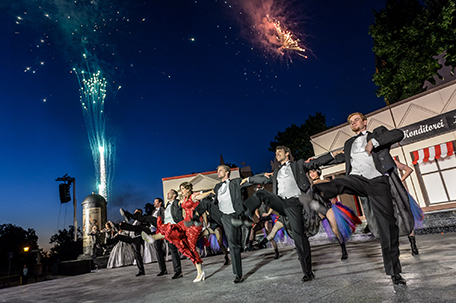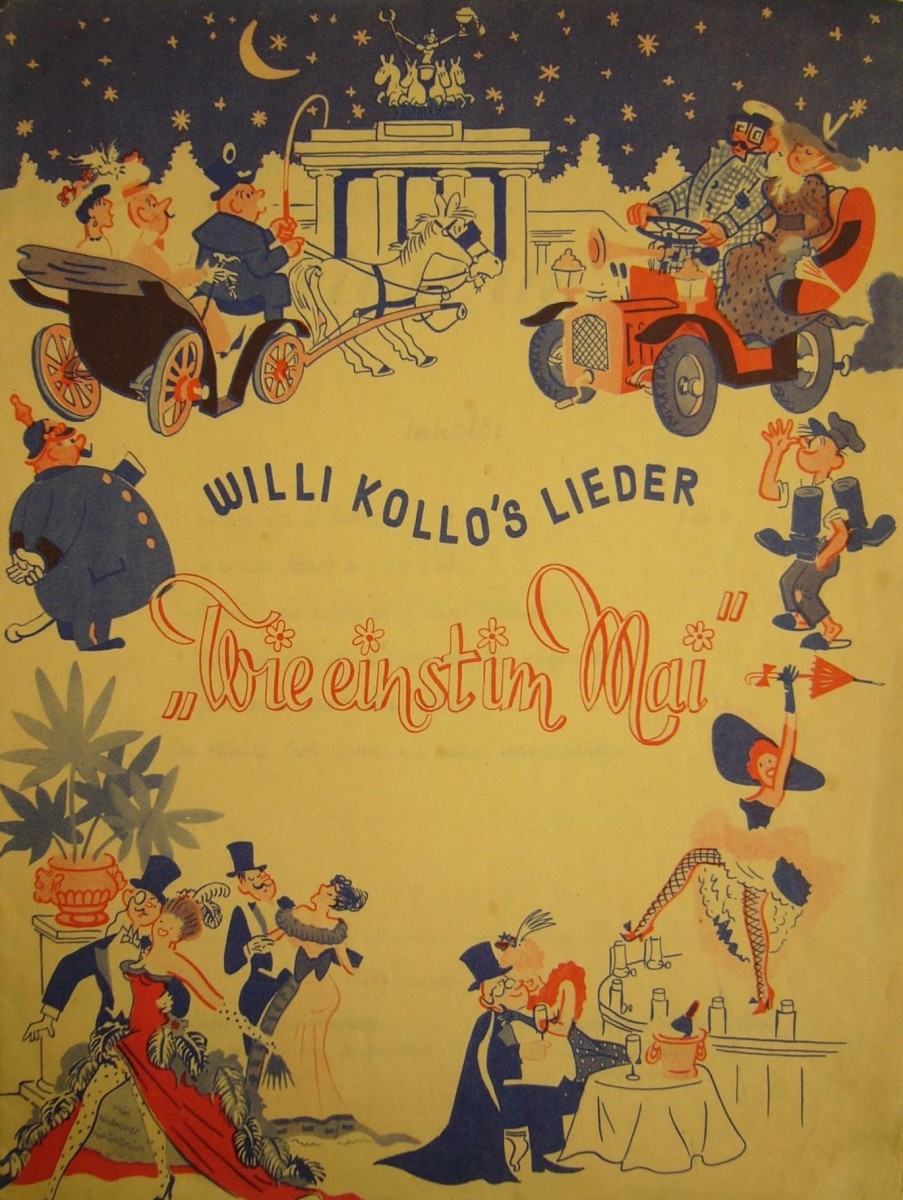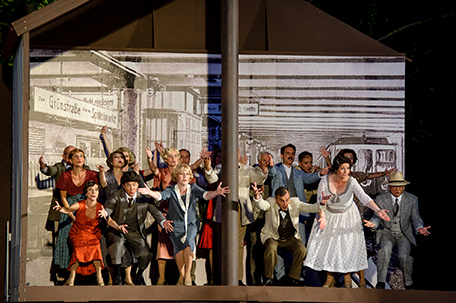John Groves
Operetta Research Center
7 July, 2018
Neustrelitz is a small, historic, beautiful, charming, quiet town, set amidst the lakes north of Berlin. For British readers: can you imagine a British town of this size having a permanent theatre with drama, dance and music theatre companies, performing virtually all the year round? “This Town Has A Theatre” proclaims a large sign as one exits Neustrelitz railway station. And indeed it does, one that stages an open-air operetta each summer in the huge garden of what used to be the Castle, which is no longer there!

Viola Zimmermann with the members of the Deutsche Tanzkompanie in “Wie einst im Mai” in Neustrelitz. (Photo: Jörg Metzner)
This year, the work chosen was Walter Kollo’s Wie einst im Mai (1913), in the re-worked and expanded 1943 edition of Walter’s son Willi, first performed at the Theater des Volkes, known as Großes Schauspielhaus in pre-Nazi years. It’s known as Maytime in its various English/American versions, a familiar title perhaps, but one rarely staged today, which is a great shame, as it is one of the most joyous of all Berlin style operettas – even in the Nazi era re-write. (Sadly, the Kollo family does not allow performances of the 1913 original, for which they would not get royalties anymore.)

Song selection from Willi Kollo’s 1943 version of “Wie einst im Mai.”
The plot, such as it is, uses the ‘love-through-the-generations’ layout, also used in Bitter Sweet, Drei Walzer, Perchance to Dream etc, allowing the authors to travel through a sentimental panorama of Berlin from 1838 through to 1943 in seven scenes.
Theater Neustrelitz is very fortunate in having a director who knows how to stage operetta: Reinhardt Friese. He was able to give energy and pace to the whole production, ensuring that the dialogue never flagged and was unfailingly amusing, that the huge acting area was well used and that musically numbers flowed seamlessly into and out of the dialogue. The direction had a lightness of touch which ensured that there was never a ‘dull moment’ in the whole three hours of the show. If only more directors of operetta had this sureness of touch – perhaps Mr Friese could give master classes to those directors who think they know what operetta is about!

The chorus in the Berlin subway, “Wie einst im Mai” in Neustrelitz. (Photo: Jörg Metzner)
The whole cast was drawn from the theatre’s ensemble, a magnificent achievement, when everyone, without exception, was perfect in their roles!
Bernd Koennes, who starts the show as Fritz, a locksmith in his twenties, impressed as Zsupan in last year’s Zigeunerbaron. This year, he has gained in confidence and the style needed for operetta, and easily and effortlessly commands the stage. The various (ageing!) roles he plays are all believable and amusing, his attractive voice able to soar effortlessly up to the heights when required.

Robert Merwald and extras in a film scene in “Wie einst im Mai” in Neustrelitz. (Photo: Jörg Metzner)
Lenz Kutzner as Ottilie (later Tilly) is most amusing, for example in the first scene which is her sixteenth birthday when she effectively plays the ‘spoiled brat’ and who is given cacti as presents by all her friends! She has a gorgeous singing voice and again is very believable as she ages and eventually becomes her granddaughter.
Stanislaus von Methusalem, who is the only character to appear as himself throughout, ends the show at the ripe old age of 105, still able to dance a frenetic gavotte, even though wheelchair bound! He is played with enthusiasm by Andres Felipe Orozco, who clearly relishes getting older! His portrayal is very funny, his singing voice completely appropriate to the role.
Viola Zimmerman as Mechthilde, Ottilie’s aged governess in Scene 1, and later a youthful Angostura has to be able to dance and sing well. Her scenes with Stanislaus are some of the many highlights of the evening: like the rest of the ensemble she has terrific vitality. (The role was originally created by the one-and-only Claire Waldoff.)

Claire Waldoff in the Kollo operetta “Drei alte Schachteln.”
In fact, there is not a weak link in this cast and I include the chorus, extra chorus, statisterie, and especially the Deutsche Tanzkompanie Neustrelitz who are all imaginatively used by the director and choreographer, Barbara Buser.
Annette Mahlendorf has designed appropriately lavish and sumptuous costumes taking the audience through over 100 years of history. Many show great imagination, such as those for Angostura, and the wigs (Juliane Stolz) for all the named roles, helping them to ‘age’ gracefully!
Her set design is most imaginative, ensuring that the three acting areas are clear, that there are various levels to add interest, and that the audience is informed about the movement forward in time, as if anyone cares about the plot!
The ever-excellent orchestra is conducted by GMD Panagiotis Papadopoulos, who, as a Greek, must have originally found German operetta very strange! Then again, he might have loved it from day 1…. His beat and the orchestra’s playing has a sure-footed lightness of touch which more than ably supports what is happening on stage.
Wie einst im Mai is the third summer operetta I have seen at Neustrelitz and is possibly the best so far! Clearly the audience at the premiere, where the guest of honour was Rene Kollo, Willi’s son, agreed, as the production was spontaneously and deservedly given a standing ovation. It is more than worthwhile booking an EasyJet flight to Berlin, and a 75 minute rail journey to Neustrelitz to see it! Highly Recommended. And I got to stay at the equally wonderful – historic – Schlossgarten Hotel, which I can also highly recommend. Thank you, Jürgen Haase for organizing the press tickets and everything else!
The most recommendable recording is the EMI one that includes Rene Kollo as Fritz, conducted by Peter Falk. There is no dialogue, but the CD includes most of the musical numbers. It was recorded in 1994.
Future operettas at Neustrelitz include the Johann Strauss II pastiche, Wiener Blut in the charmingly beautiful tiny theatre in the autumn of 2018, and Kalman’s Bajadere in the summer of 2019. And let’s not forget, the theatre will also present the most glorious of all ‘oriental’ operettas next season: Kismet. (A title virtually unknown in the German speaking theater world.)
For more information and performance dates, click here.
